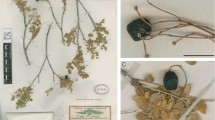Summary
The misinterpreted Thrixspermum hewittii (based on Dendrocolla minima Ridl., non Blume) is transferred to Pennilabium. The species is still only known from the type collection from Sarawak and is here illustrated for the first time.
Similar content being viewed by others
Introduction
Ridley (1908) described one of the smallest orchids of Borneo as Dendrocolla minima, calling it “a very odd little thing.” The short-stemmed, monopodial plant is barely 2.5 cm across between the tips of the leaves; the patent racemes are somewhat shorter than the leaves and are noteworthy for the many, crowded, recurved bracts, with the minute flowers arising in succession, one at a time. The prominently spurred flower is about 3 mm in diameter between the tip of the dorsal sepal and the tip of the spur. It is only known from the type collection (Beaman et al. 2001: 390).
In naming this species, Ridley overlooked that the same epithet had previously been used in Dendrocolla by Blume for a different species, currently known as Chroniochilus minimus (Blume) J. J. Sm. Moreover, Dendrocolla is now considered to be a synonym of Thrixspermum. Ridley’s species was transferred to that genus by Ames (1921), as T. hewittii, the new epithet referring to the collector of the type, John Hewitt. In his overview of the genus Thrixspermum, Schlechter (1911) remarked that D. minima Ridl. should probably be excluded from Thrixspermum, but refrained from suggesting an alternative generic disposition. Much later, Garay (1972) transferred T. hewittii to Porphyrodesme, a genus now included in Renanthera (Kocyan & Schuiteman, in prep.). This puzzling transfer, already questioned by Wood & Cribb (1994: 357), seems to have been motivated by Ridley’s somewhat vague description of the labellum, which may be read as resembling that of a Porphyrodesme. However, Porphyrodesme and T. hewittii have little in common. Species of Porphyrodesme are fairly robust plants with elongate stems up to a metre or so long, with multi-branched panicles, carrying numerous flowers, many of which open simultaneously. The bucket-shaped lip is quite different from the spurred one of T. hewittii, the rostellum of Porphyrodesme is not straight and not almost needle-like as in T. hewittii, and the rachis of Porphyrodesme lacks the concavities from which the pedicels arise in T. hewittii.
A careful examination of the sparse isotype material at K led to the somewhat unexpected conclusion that Thrixspermum hewittii is in fact a member of the genus Pennilabium. The floral morphology is characteristic for this genus, with a footless column, an elongate rostellum, a long-spurred lip with prominent, flap-like sidelobes, a short, callus-like midlobe, and a spur without internal ornamentation. The flowers open in succession and the pedicels arise from a concavity in the rachis, as in the other members of Pennilabium. It differs from the hitherto known species of this genus in the reduced size of the vegetative parts and the minute flowers as well as the condensed rachis with recurved bracts.
Taxonomy
Pennilabium hewittii (Ames) Schuit., comb. nov., Fig. 1.
http://www.ipni.org/urn:lsid:ipni.org:names:77133521-1
Thrixspermum hewittii Ames, J. Straits Branch Roy. Asiat. Soc., Spec. No.: 194 (Ames 1921).
Dendrocolla minima Ridl. (Ridley 1908: 139), nom. illegit. (non Blume 1825). Type: Sarawak, Kuching, Hewitt s.n. [“27” on additional hand-written label at K], Jan. 1907 (holotype SING; isotypes K!, SAR).
Porphyrodesme hewittii (Ames) Garay (1972: 191).
Pennilabium is a genus of 15 species in the subtribe Aeridinae and is distributed from Northeast India to the Philippines, with centres of diversity in Peninsular Malaysia and Borneo. As noted by O’Byrne (2009), “All the species are considered uncommon or rare, occurring as small colonies that are widely separated from each other.” Moreover, as far as could be ascertained, all species have ephemeral flowers, which further contributes to their extreme scarcity in herbarium collections.
Very little is known about Pennilabium hewittii. Ridley stated that the flowers were “apparently” pink. The pollinia were not described and were not found in the material at K. In the other known species of Pennilabium there are two solid (i.e. not cleft or porate) pollinia. The habitat of P. hewittii was not recorded; judging from its (former?) occurrence at Kuching it is probably a twig epiphyte in lowland rainforest. The fact that it has not been seen for more than a century could indicate that it has become extinct. On the other hand, such a minute epiphyte is easily overlooked; P. hewittii may still occur in forest remnants in western Sarawak or Kalimantan, awaiting rediscovery.
References
Ames, O. (1921). In: E. D. Merrill, A bibliographic enumeration of Bornean plants. J. Straits Branch Roy. Asiat. Soc., Spec. No.: 1 – 637.
Beaman, T. E., Wood, J. J., Beaman, R. S. & Beaman, J. H. (2001). Orchids of Sarawak. Natural History Publications (Borneo), Kota Kinabalu, in association with the Royal Botanic Gardens, Kew.
Blume, C. L. von (1825). Bijdragen tot de flora van Nederlansch Indië 7: 290. Lands drukkerij, Batavia.
Garay, L. A. (1972). On the systematics of the monopodial orchids I. Bot. Mus. Leafl., Harvard Univ. 23 (4): 149 – 212.
O’Byrne, P. (2009). Pennilabium armanii: a new species from Peninsular Malaysia. Malesian Orchid J. 3: 113 – 116.
Ridley, H. N. (1908). New or rare Malayan plants. Series IV. J. Straits Branch Roy. Asiat. Soc. 50: 111 – 152.
Schlechter, R. (1911). Die Gattung Thrixspermum Lour. Orchis 5: 46 – 48, 54 – 58.
Wood, J. J. & Cribb, P. J. (1994). A checklist of the orchids of Borneo. Royal Botanic Gardens, Kew.
Author information
Authors and Affiliations
Corresponding author
Rights and permissions
About this article
Cite this article
Schuiteman, A. A very odd little thing: Pennilabium hewittii (Orchidaceae). Kew Bull 68, 679–681 (2013). https://doi.org/10.1007/s12225-013-9476-7
Accepted:
Published:
Issue Date:
DOI: https://doi.org/10.1007/s12225-013-9476-7





